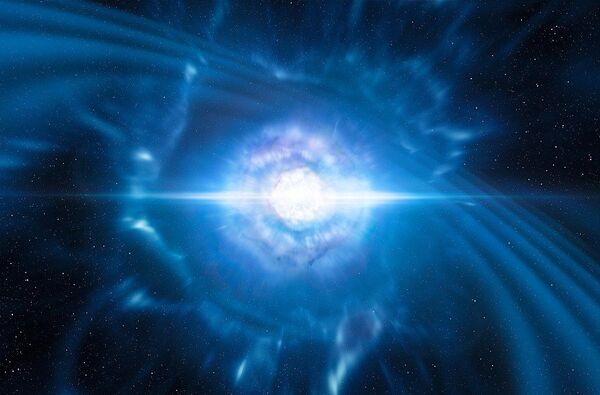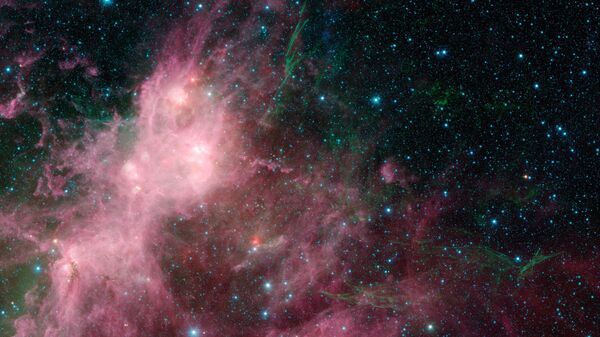An international team of scientists is seeking to detect, measure and study a signal from the obscure, starless “dark age” of the Universe, that has travelled through space for 13 billion years.
Researchers from the University of Washington, the University of Melbourne, Curtin University and Brown University had claimed in a report published in the Astrophysical Journal last year they had achieved an almost 10-fold improvement of radio emission data gathered by the Murchison Widefield Array telescope in Western Australia.
Curtin University researchers have developed a particle detector at the remote site of the Murchison Widefield Array radio #telescope that is capable of conducting a ground-breaking study into mysterious #cosmicrays pic.twitter.com/tRu0PPfiJc
— Curtin Media (@CurtinMedia) January 15, 2019
Now, the team is analyzing this data in the search for a signal from the "dark age" of our universe, that could be invaluable for unlocking major questions about the universe today.
"We think the properties of the universe during this era had a major effect on the formation of the first stars and set in motion the structural features of the universe today… The way matter was distributed in the universe during that era likely shaped how galaxies and galactic clusters are distributed today," said Miguel Morales, a UW professor of physics, and a member of the team.
‘The Dark Age’
Before the starless period of the Universe, the latter was hot and dense, with electrons and photons trapping each other and rendering it opaque.
These interactions between electrons and photons grew rare when the universe was less than a million years old.
As it expanded, it became increasingly transparent and dark. Throughout this dark period, which lasted hundreds of millions of years, neutral hydrogen dominated the cosmos.
"For this dark age, of course there's no light-based signal we can study to learn about it—there was no visible light. But there is a specific signal we can look for. It comes from all that neutral hydrogen,” said Morales, quoted by Phys. org.
He added that the signal, although never measured, has been established as being out there.
The team of scientists have been using the Murchison Array telescope, made up of 4,096 dipole antennas that pick up low-frequency signals. The electromagnetic signature of neutral hydrogen is just such a signal, which is typically difficult to detect due to electromagnetic "noise" from other sources in the cosmos: activity from stars, galaxies and even man’s technology. All this has drowned out the signal from the neutral hydrogen.
Radioastronomers look to hydrogen for insights into the Universe’s first billion years. They are trying to detect a line in the spectrum of hydrogen with a wavelength of 21 cm: https://t.co/HzdvXcOK9y
— Xavi Bros (@Xavi_Bros) August 15, 2019
Image: Murchison Widefield Array, Australia Dr John Goldsmith/Celestial Visions pic.twitter.com/bvL2FaSsqp
The researchers have come up with a means of filtering this “noise” in their quest to detect the elusive signal, and in 2019 they announced that they had filtered out electromagnetic interference from more than 21 hours of Murchison Array data.
The electromagnetic radio emission signal that the researchers hope to study is one emanated by the neutral hydrogen at a wavelength of 21 centimeters.
However, since the emission occurred, the universe has expanded, stretching the signal out to nearly 2 meters.
According to the researchers, the signal should potentially contain information shedding light on the dark age and the events that brought an end to it.
Advent of Stars
The “dark age” of the Universe came to an end when it was 1 billion years old, as hydrogen atoms began to aggregate and form the first stars.
Their light sparked a new era, the Epoch of Reionization.

The energy from the stars converted much of the neutral hydrogen into an ionized plasma that dominates interstellar space to this day.
"The Epoch of Reionization and the dark age preceding it are critical periods for understanding features of our universe, such as why we have some regions filled with galaxies and others relatively empty, the distribution of matter and potentially even dark matter and dark energy," said Morales.
Looking ahead, the team of scientists hope to forge ahead with the filtering interference from about 3,000 hours of additional emission data collected by the radio telescope, which ought to bring them even closer to the signal from the dark age and the secrets it might help to reveal.


